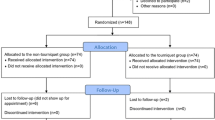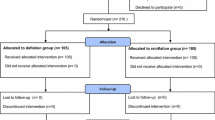Abstract
Background
Many studies have investigated the effect of tourniquet release time and closed suction drainage in total knee arthroplasty (TKA). However, controversy remains as to the advisability of preclosure tourniquet release and the advisability of closed suction drain use following total knee arthroplasty.
Questions/Purposes
The aim of the study was to investigate if there is a benefit of performing tourniquet release after skin closure, along with drain clamping, for the first 6h following TKA.
Methods
Ninety-six patients underwent TKA between May 2009 and April 2010. Fourteen of these were excluded because of systemic diseases and simultaneous bilateral TKA. Twenty-nine of these were excluded due to use of a patellar component and posterior cruciate ligament (PCL)-sacrificing systems. Thus, 53 patients that underwent PCL-retaining cemented TKA were reviewed retrospectively. In the control group (group C), the tourniquet was released before skin closure, an attempt at hemostasis was made, and a compressive bandage was applied. The drain was not clamped in these patients. The test group of 23 patients (group T) had tourniquet release after skin closure and after the compressive bandage was applied. The drain was clamped for the first 6h after surgery. The two groups were compared as to the amount of drained blood, postoperative change in hemoglobin, postoperative complications, and knee function.
Results
We found that drained blood and hemoglobin drop were significantly lower in group T compared with group C. There was no difference regarding postoperative complications and knee function.
Conclusion
We conclude that tourniquet release after skin closure and compressive dressing followed by 6h of drain clamping reduces postoperative blood loss in TKR surgery.
Similar content being viewed by others
References
Barwell NJ, Anderson G, Hassan A, et al. The effects of early tourniquet release during total knee arthroplasty. A prospective randomized double-blind study. J Bone Joint Surg Br Mar. 1997; 79(2): 265–8.
Beer KJ, Lombardi AV Jr, Mallory TH. The efficacy of suction drains after routine total joint arthroplasty. J Bone Joint Surg Am. 1991; 73(5): 584–7.
Cao L, Ablimit N, Mamtimin A, et al. Comparison of no drain or with a drain after unilateral total knee arthroplasty: a prospective randomized controlled trial. Zhonghua Wai Ke Za Zhi. 2009; 15;47(18): 1390–3.
Christodoulou AG, Ploumis AL, Terzidis IP, Chantzidis P, Metsovitis SR, Nikiforos DG. The role of timing of tourniquet release and cementing on perioperative blood loss in total knee replacement. Knee. 2004; 11(4): 313–7.
Esler CN, Blakeway C, Fiddian NJ. The use of a closed suction drain in total knee arthroplasty. A prospective, randomised study. J Bone Joint Surg Br. 2003; 85(2): 215–7.
Fukuda A, Hasegawa M, Kato K, Shi D, Sudo A, Uchida A. Effect of tourniquet application on deep vein thrombosis after total knee arthroplasty. Arch Orthop Trauma Surg. 2007; 127: 671–5.
Hersekli MA, Akpinar S, Ozkoc G. The timing of tourniquet release and its influence on blood loss after total knee arthroplasty. Int Orthop. 2004; 28(3): 138–141.
Holt BT, Parks NL, Engh GA, et al. Comparison of closed suction drainage and no drainage after primary total knee arthroplasty. Orthopedics. 1997; 20(12): 1121–4.
Ishii Y, Matsuda Y. Effect of the timing of tourniquet release on perioperative blood loss associated with cementless total knee arthroplasty: a prospective randomized study. J Arthroplasty. 2005; 20(8): 977–83.
Kiely N, Hockings M, Gambhir A. Does temporary clamping of drains following knee arthroplasty reduce blood loss? A randomised controlled trial. Knee. 2001; 8(4): 325–7.
Kim YH, Cho SH, Kim RS. Drainage versus nondrainage in simultaneous bilateral total knee arthroplasties. Clin Orthop Relat Res. 1998; 347: 188–93.
Klenerman L. Is a tourniquet really necessary for total knee replacement. J Bone Joint Surg [Br]. 1995; 77-B: 174–5.
Larsson J, Lewis DH, Liljedahl SO, Lofstrom JB. Early biochemical and hemodynamic changes after operation in a bloodless field. Eur Surg Res. 1977; 9(5): 311–20.
Page MH, Shepherd BD, Harrison JM. Reduction of blood loss in knee arthroplasty. Aust NZ J Surg. 1984; 54(2): 141–4.
Prasad N, Padmanabhan V, Mullaji A. Comparison between two methods of drain clamping after total knee arthroplasty. Arch Orthop Trauma Surg. 2005; 125(6): 381–4.
Rama KR, Apsingi S, Poovali S, Jetti A. Timing of tourniquet release in knee arthroplasty. Meta-analysis of randomized, controlled trials. J Bone Joint Surg Am. 2007; 89: 699–705.
Reilly TJ, Gradisar IA Jr, Pakan W, Reilly M. The use of postoperative suction drainage in total knee arthroplasty. Clin Orthop Relat Res. 1986; 208: 238–242.
Ritter MA, Keating EM, Faris PM. Closed wound drainage in total hip or total knee replacement. A prospective, randomized study. J Bone Joint Surg Am. 1994; 76(1): 35–8.
Ryu J, Sakamoto A, Honda T, Saito S. The postoperative drain-clamping method for hemostasis in total knee arthroplasty: reducing postoperative bleeding in total knee arthroplasty. Bull Hosp Jt Dis. 1997; 56(4): 251–4.
Sakihara H et al. A method to control postoperative bleeding after total knee replacement. Seikei-saigaigeka. 1998; 31: 543–5 (in Japanese).
Steffin B, Green-Riviere E, Giori NJ. Timing of tourniquet release in total knee arthroplasty when using a postoperative blood salvage drain. J Arthroplasty. 2009; 24(4): 539–42.
Thorey F, Stukenborg-Colsman C, Windhagen H, Wirth CJ. The effect of tourniquet release timing on perioperative blood loss in simultaneous bilateral cemented total knee arthroplasty: a prospective randomized study. Technol Health Care. 2008; 16(2): 85–92.
Widman J, Isacson J. Surgical hemostasis after tourniquet release does not reduce blood loss in knee replacement. A prospective randomized study of 81 patients. Acta Orthop Scand. 1999; 70(3): 268–70.
Yamada K, Imaizumi T, Uemura M, Takada N, Kim Y. Comparison between 1-hour and 24-hour drain clamping using diluted epinephrine solution after total knee arthroplasty. J Arthroplasty. 2001; 16(4): 458–62.
Acknowledgments
We thank Ibrahim Yanmis, MD, Dogan Bek, MD, Huseyin Ozkan, MD, Yuksel Yurttas, MD, Atıl Atilla, MD, and Zafer Atbasi, MD, in Gulhane Military Medicine Academy for their contribution to the study.
Disclosures
ᅟ
Conflict of Interest:
Kenan Koca, MD, Cemil Yildiz, MD, Necmettin Kocak, MD, Servet Tunay, MD, and Mustafa Basbozkurt, MD, have declared that they have no conflict of interest.
Human/Animal Rights:
All procedures followed were in accordance with the ethical standards of the responsible committee on human experimentation (institutional and national) and with the Helsinki Declaration of 1975, as revised in 2008 (5).
Informed Consent:
Informed consent was obtained from all patients for being included in the study.
Required Author Forms
Disclosure forms provided by the authors are available with the online version of this article.
Author information
Authors and Affiliations
Corresponding author
Additional information
Level of Evidence: Therapeutic Study Level III. See “Levels of Evidence” for a complete description.
Rights and permissions
About this article
Cite this article
Yildiz, C., Koca, K., Kocak, N. et al. Late Tourniquet Release and Drain Clamping Reduces Postoperative Blood Loss in Total Knee Arthroplasty. HSS Jrnl 10, 2–5 (2014). https://doi.org/10.1007/s11420-013-9363-7
Received:
Accepted:
Published:
Issue Date:
DOI: https://doi.org/10.1007/s11420-013-9363-7




